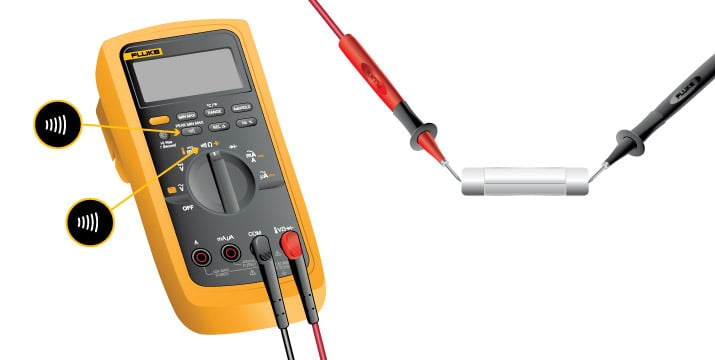Get Continuity Test. This is a quick video of me showing you how to test for continuity with a multimeter.
When testing for continuity, a multimeter beeps based on the resistance of the component being tested. That resistance is determined by the range setting of the multimeter.
Examples: If the range is set to 400. Learn how to use a multimeter and how to check continuity with a multimeter.
There are various companies which base their production on making electrical gadgets. Testing continuity using a Multimeter also helps in checking if a material is a good or bad conductor of electricity. They have to be sure that the materials they use will conduct electricity or not.
There are mainly two methods for checking the continuity of a circuit using a multimeter. The first method is to use the continuity mode in the multimeter, which is specially made for this purpose.
The second method is to use the Ohmmeter. To test the multimeter device to ensure that it has a strong enough battery and is functioning correctly, start by turning on the continuity mode and then touch both the red and black terminals together.
If your device shows 0. Digital Multimeter Auto-ranging with NVC, Test Amp Voltage Ohm Diode Continuity Frequency with Backlight LC Test Leads and Screwdriver - Tacklife DM02A 4. Your multimeter can test continuity by sending little current by one probe and determine if it was received by the other probe. If a connection is present between the probes through directly touching each other or continuous circuit, the test current flows through.
The screen of your multimeter will show a value of zero and beeps. To use the multimeter continuity function, switch the multimeter dial to the continuity test function.
Touch the multimeter leads together and you should hear an audible "beep" sound. It is best to always touch the leads together and check for the beep before testing. This is done so that you know that the continuity function is working.
Steps for checking the continuity using a multimeter. Once you have the multimeter make sure you have read the complete instructions on it, as every multimeter is different. You need to start by checking the hot lead of the coax table first for continuity. A continuity test is assessing the flow of electrical current within an electric circuit.
A multimeter or a multitester, also known as a VOM (volt-ohm-milliammeter), is an electronic measuring instrument that combines several measurement functions in one unit. A typical multimeter can measure voltage, current, and resistance. Analog multimeters use a microammeter with a moving pointer to display readings. Testing for continuity is an easy and reliable way to determine whether a switch or outlet has internal damage.
This test can be applied to a circuit as a whole or in sections—on individual components or sections of wiring. Devices that can be used to perform continuity tests include multimeters which measure current and specialized continuity testers which are cheaper, more basic devices, generally with a simple light bulb that lights up when current flows. Only a close complete circuit (one that is switched ON) has continuity.
During a continuity test, a digital multimeter sends a small current through the circuit to measure resistance in the circuit. The multimeter tests continuity by sending a little current through one probe, and checking whether the other probe receives it. If the probes are connected—either by a continuous circuit, or by touching each other directly—the test current flows through.

Connect your multimeter probes to each end of the wires. AstroAI Digital Multimeter with Ohm Volt Amp and Diode Voltage Tester Meter Continuity Test (Dual Fused for Anti-Burn) 4. Check your reading.
A false signal or incorrect result will impact on your work badly. A Continuity Test is used to check if a Circuit is Open or Closed. Remember, only a Complete Closed Circuit will Pass Continuity Test.

You can additionally test that the continuity attribute works on your multimeter by touching both probes to each other. This finishes the circuit and your multimeter should allow you recognize that. Continuity is a test you carry on your wire, using a multimeter to detect the resistance of the wire. It proves the path of a complete flow of current through your wire.
In the popular EEVBlog multimeter, page of the Datasheet states the continuity threshold is between and 4ohms. These few examples are enough to determine that there is no standard value. If the information cannot be found in the datasheet of your particular model, then getting a few resistors between - 2ohms and measuring them should be enough to tell you the threshold.
You can easily verify that you have correctly set the multimeter to continuity mode by pressing the probes together. If the multimeter is set on continuity mode, it will produce a beeping sound. Place black probe to the negative side of the bulb. Take the red probe and for a moment press it against the positive pole.

A digital multimeter’s Continuity Test mode can be used to test switches, fuses, electrical connections, conductors and other components. A good fuse, for example, should have continuity.
A DMM emits an audible response (a beep) when it detects a complete path.
Nessun commento:
Posta un commento
Nota. Solo i membri di questo blog possono postare un commento.